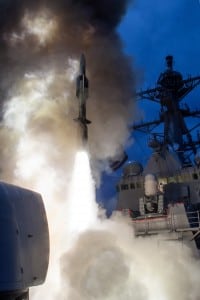The Missile Defense Agency’s (MDA) fiscal year 2024 budget request is seeking $10.9 billion, up slightly from the $10.5 billion it was given for 2023, and with a large focus of the funding on defense of Guam.
After Congress added almost $1 billion to MDA’s FY ‘23 request, this latest request maintains research and development as the largest portion of MDA funding. The agency is seeking $8.7 billion for R&D, up from $8.3 billion in the enacted FY’23 budget.

However, procurement is down from over $1.6 billion in FY ‘23 to only $1.45 billion in FY ‘24 while operations and maintenance funds would rise slightly from $542 million in FY ‘23 to $564 million in FY ‘24.
MDA procurement funds are partially focused on buying 11 Terminal High Altitude Area Defense (THAAD) interceptors, 27 Standard Missile (SM)-3 Block IB missiles, and 12 SM-3 Block IIA missiles.
Notably, MDA is requesting $801 million to start building and continue developing its architecture to defend Guam for air and missile threats., with $632 million devoted to R&D efforts.
Last year, MDA announced the architecture it chose to defend Guam includes mobile unit versions of the Aegis Combat System, Raytheon Technologies [RTX] Standard Missile (SM)-3 and SM-6 missiles, the Northrop Grumman [NOC] Integrated Air and Missile Defense Battle Command System (IBCS), and maintain the THAAD system battery already deployed on Guam (Defense Daily, March 29, 2022).
In this new FY ‘24 funding request, $398 million of the Guam funds are dedicated to continue developing integrated missile defense of Guam, supporting the Pacific Deterrence Initiative. This funding includes development of the AN/TPY-6 radar for long-range midcourse discrimination, precision tracking and hit assessment; developing the Aegis Guam System to interface with the dispersed AN/TPY-6 radar, and dispersed MK41 Vertical Launcher System (VLS); and integration and control of a new Army missile launcher.
During a briefing on Monday, MDA Director Adm. Jon Hill said the AN/TPY-6 radars will be deployed on the “periphery” of the island to best meet Indo-Pacific Command requirements for a 360-degree picture, tied into Aegis system defense for ballistic missiles.
Hill reiterated that the Guam defense systems will also include the Army’s IBCS that will use the Raytheon Lower Tier Air and Missile Defense Sensor (LTAMDS) and Sentinel radars to fill in the gap for defense against cruise missiles and hypersonic weapons.
“Then we tie that together in a command suite that is brought together on a C2BMC screen so that the commander has the ability to understand that total battle, from what we’re seeing coming in from space, which are your ballistic tracks or your hypersonic tracks, so that when we pick up cruise missile tracks over an LTAMDS, we can make sure that those are being seen and deconflicted by the other parts of the system,” Hill said during the budget briefing.
Hill also characterized the mix of a new mobile Army MK41 VLS to intercept threats as not Aegis Ashore, but “a disaggregated version of that, just given the land and the topography of the island.”

Another $170 million of the MDA funding goes toward Guam system procurement, particularly Aegis Guam System and vertical launch equipment to support the final delivery schedule.
Separately, MDA is requesting $3.3 billion total for the Ground-based Midcourse Defense (GMD) homeland missile defense system.
The largest piece of the GMD funding is $2.1 billion to continue working on the Next Generation Interceptor (NGI), which is planned to improve upon the Ground Based Interceptor in the Ground-based Midcourse Defense homeland missile defense system.
This funding is geared toward continuing to fund, design, develop, prototype, integrate and conduct relevant environmental testing to mature the NGI booster, payload, sensors and “design-specific critical technologies and technology elements to reduce technical risk,” MDA’s budget overview document said.
In 2021, MDA selected teams led by Northrop Grumman [NOC] and Lockheed Martin [LMT] to start initial technology development and risk reduction work for the NGI, with competition set to proceed at least through the critical design review phase (Defense Daily, March 23, 2021).
MDA’s budget documents confirmed the agency still plans to field the NGI system by 2028 and that it will feature a multiple kill vehicle payload, improved system survivability, and improved performance against projected North Korean missile threats.
The agency is also requesting $904 million to upgrade and improve the GMD system. This includes plans to complete developing, testing and fielding the Ground System 8 software build that gives a 2/3 stage selectable stage employment capability for GBIs, improves discrimination, integrates the Long Range Discrimination Radar (LRDR) with the GMD Fire Control system, and improves cybersecurity.
This funding will also support modernization of the GMD Fire Control system and In-Flight Interceptor Communications System Data Terminal modernization.
MDA also plans to develop Ground Weapon Systems 10A and 10B to integrate the missile defense system track and ability to plan and coordinate engagements with NGI as well as support increased two-way data transmissions with interceptors in flight and improve cyber resiliency.
A budget overview document said part of this GMD funding will be used to complete the Service Life Extension Program (SLEP) on four GBIs with the new Configuration 2 booster.